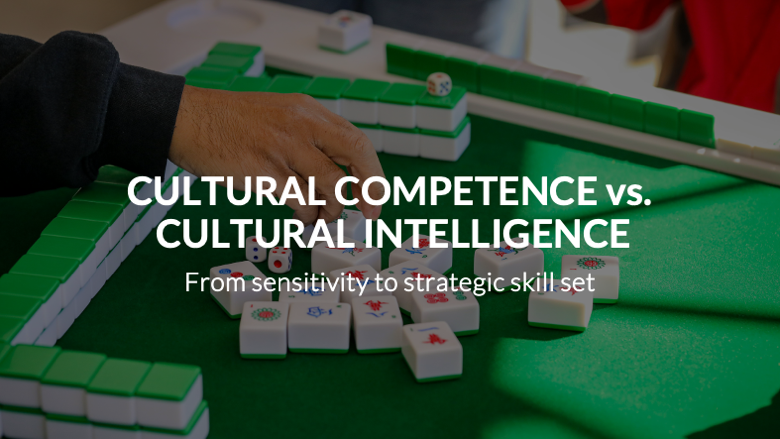
Whether I’m talking with my kids, interacting with our staff, or speaking to a group of executives, one of the themes I talk about more than any other is the importance of “perspective taking”. Perspective taking is the ability to step outside our own experience and consider something from another person’s point of view. It’s something we do unconsciously all the time. What kind of gift would they enjoy? How is my colleague going to interpret this email? What does that group think about me? But we’re less likely to engage in perspective taking if the individuals with a different perspective aren’t part of our in-group. —
Research reveals that perspective taking is a skill that can be developed—and that’s good news. Perspective taking is one of the most critical skills needed to manage unconscious bias and lead with cultural intelligence. You can’t motivate people and negotiate effectively if you don’t know how others think and feel about something. And there’s mounting evidence that perspective taking makes a critical difference in whether diversity training actually works.
Most of us do perspective taking quite naturally with those from our in-group—our friends, loved ones, and people like us. But we’re less likely to slow down and consider another’s perspective if they are outside our in-group. Think of the age-old psychological notion of fundamental attribution error—the assumption that someone’s negative behavior stems from a character flaw while excusing the same behavior in ourselves due to external circumstances. Here’s how fundamental attribution error works: If someone’s phone rings in the movie theatre, my default assumption is that they’re a rude or forgetful person who is inconsiderate of others. But if my phone rings, surely people know that it’s only because I’m awaiting an urgent phone call in the midst of a crisis. This isn’t my usual behavior! According to fundamental attribution error, I’m more likely to give the benefit of the doubt to people who “look like me.”
The greater the cultural distance, the more important it is to exercise perspective taking. Use this informal inventory to reflect on your perspective taking skill:
1. When giving someone directions to a restaurant, do you change the way you explain the directions based on whether the individual is an out-of-town visitor versus a local?
2. When telling a story, do you tell it differently based on the audience? (e.g., amount of details provided, references to things they do/don’t know about, etc.).
3. When providing instructions on how to do something, are you aware of how much the other individuals already know about this task? Do you over-explain the instructions even though they provide cues that they understand? Or do you use lingo that leaves them confused?
4. When an acquaintance asks where you live, do you give the same response to someone on the other side of the world as you do someone from your own region? (e.g., “Grand Rapids, Michigan” versus “In the central part of the U.S., near Chicago.”)
5. Think about a work challenge you’re currently facing right now. To what degree can you accurately describe the perspectives of 3-5 colleagues who are also facing the same challenge?
6. Identify an issue you feel strongly about (e.g., climate change, politics, gay marriage, etc.). To what degree can you offer a coherent argument that represents the opposite of your perspective?
7. How often do you say things like “As you know,” or “Given your experience in this area…”?
Perspective taking doesn’t mean you give up your own perspective or lack conviction. In fact, this is one of the critical differences between perspective taking and empathy. Empathy may go too far in some situations. A member of the special forces who empathizes with the enemy or a sales person who is distraught about a customer’s complaints may fail to fulfill the mission of their respective organizations. But there is no way to succeed without some understanding of the “other side’s” perspective.
Perspective taking is best developed in relationship. Many people change or at least reevaluate their dogmatic views about sexual orientation, religion, or politics when a friend or loved one is the one who represents the opposing perspective. Conversation and dialogue are the best ways to learn about another’s perspective. But there are some other practical steps you can use to develop the skill of perspective taking.
—Curate a more diverse social media feed. You’ll quickly see wildly different interpretations of the same current events.
—Use the ten cultural value dimensions to consciously consider the differences in how someone from either extreme would view a new initiative (e.g., an individual with a low uncertainty avoidance orientation may be more drawn to something new than someone who is high uncertainty avoidance).
—Use Bezo’s “empty-chair strategy” at important meetings to represent a perspective that won’t likely be present by the individuals in the meeting.
—When discussing a challenging issue with someone, see if each of you can articulate the other person’s perspective. Clarify whether you have an understanding of each other’s perspective.
—In the words of our friend and colleague Adam Grant, “Argue like you’re right. Listen like you’re wrong.”
Seek to understand. It’s one of our mantras at the Cultural Intelligence Center. We know that diverse perspectives x CQ creates better solutions. We don’t do it perfectly ourselves. But we’re resolved to keep at it. I hope you will continue the pursuit with us.
[See Chapter 3 in Driven by Difference to learn about the critical link between perspective-taking, CQ, and innovation. ]



